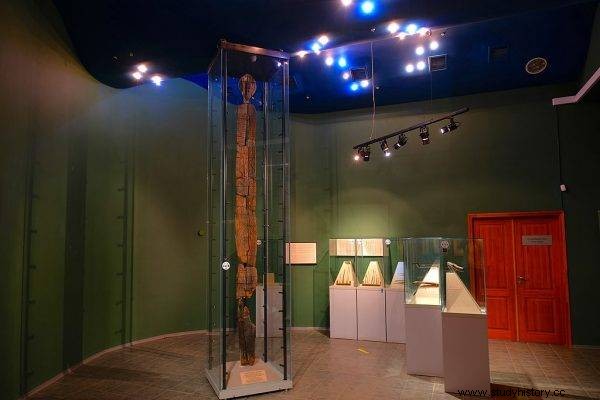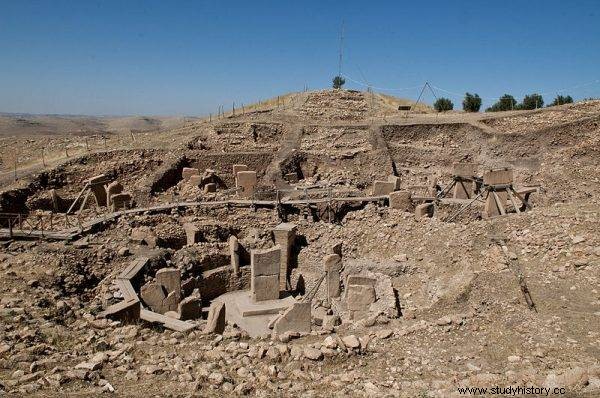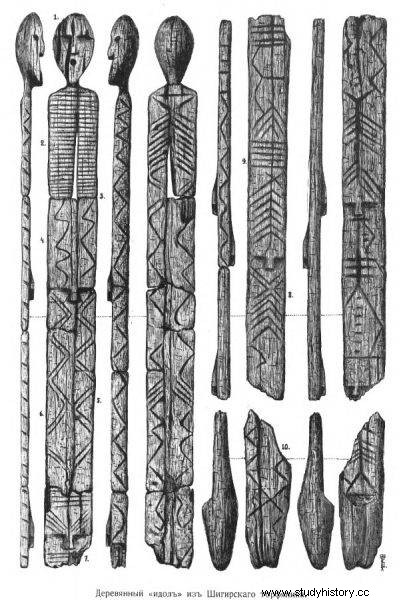For years scientists have been amazed by the sculpture known as the idol Szygirski. They estimate that it may even be over 11,000 years old! What was she? And how was it even created?
There are many mysteries of antiquity. But the secrets of even earlier times are incomparably more. For years scientists have been amazed by the sculpture commonly known as the idol Szygirski. Virtually each of his research brought new answers about the time of its creation ... And they took this moment back to the point of impossible! Or at least they made the admiration for its creators grow more and more. But what was this sculpture anyway?
How did the idol survive?
It is the end of the 19th century. In 1894, in a peat bog 100 kilometers north of Yekaterinburg, on the eastern side of the Ural Mountains, the lake (or peat bog - depending on the source) was drained. At a depth of about 4 meters, the workers of the local gold mine found something that was by no means gold. But it looked even more interesting. They were pieces of wood, making up a long (or rather high) idol over 5 meters. In addition to him, also found the so-called "Little" idol Szygirski .

It is estimated that the original height of the "big" idol was around 5–5.3 meters. Only the "top" 2.8 meters have survived to our times.
It is estimated that the original height of the "big" idol was around 5–5.3 meters. Only the "top" 2.8 meters have survived to our times. It showed not only various patterns. He even had a characteristic oval head with carved eyes and a mouth in the form of the letter "o". At first, no one attached much importance to this sculpture. It was believed that it could be several thousand years old at most. Recent research has shown how wrong people have been wrong about this…
Anatomy of a "giant"
The entire sculpture was made of only one larch tree log. Its creators were probably representatives of the hunter-gatherer community. The idea that they could be members of the early farming communities was rejected. Decorations on the idol - according to Mikhail Žilin from the Institute of Archeology of the Russian Academy of Sciences in Moscow - may represent forest spirits or even demons. According to various opinions, the zigzag patterns could have served some kind of a warning function. Perhaps a taboo place was marked in this way. For others, they bring to mind, for example, meanders of rivers.
Interestingly, the idol Szygirski was associated by scientists (also by Žilin) with other finds, only… surprisingly distant. These are stone sculptures over 5 meters high, found 2,500 kilometers further:at the Göbekli Tepe archaeological site in Turkey. They are believed to have ritual significance.

photo:Teomancimit / CC BY-SA 3.0 Scientists associated Idol Szygirski with stone sculptures found at the archaeological site of Göbekli Tepe in Turkey.
Coming back to our idols:one of the authors looks for a specific role, especially the smaller one. Analyzing its structure, he suggests that may have acted as an astronomical instrument. Was he something like a sundial? The location of the sculpture's prominent nose, which could function as a gnomon, leads to this conclusion. There are exactly 12 dimples on either side of the chin, which makes you think of 12 hours or 12 months. But how much would such a watch show the exact time? (After all, it would require that there were also dimples on the forehead.) And is it even possible to think that representatives of the transural tribes would have come up with such an ambitious idea?
What do we know about the Szygir culture?
The aforementioned Mikhail Žilin continued to work in the area where the idol was found, expecting more artifacts. And he was right. First of all, many bone arrowheads, harpoons and daggers from more or less the same period have been found. And also clear evidence that the inhabitants of those areas were able to work with wood. Stone hatchets were discovered there as well as a piece of a pine log processed with such an hatchet. It is also a fact that the so-called the transural tribes left many interesting traces . In those areas there was a rather developed community at that time. Its presence dates from the Late Paleolithic to the Early Mesolithic. In addition to the idol, they left behind, among others two caves full of rock paintings.

photo:public domain The mere fact of finding a well-preserved sculpture is extraordinary. It was probably only possible thanks to the specific conditions in Siberia
However, not everything that was found there was classified as products of the Szygir culture. The latter includes only the oldest finds. These later are treated as products of the so-called Gorbunov culture. It is estimated that it could have replaced the Szygir culture around the 3rd millennium BC.
The analysis of early findings from peat bogs is made difficult by the fact that these areas were used for commercial purposes at some stage, which sometimes made it difficult to determine the correct chronology. For example, arrowheads from later periods were slightly shorter than those of Szygirski. Interestingly, similarities to "later" type arrowheads are shown by those found, for example, in the Baltic Sea region, in Estonia.
Ancient cemeteries
Apart from the peat bog, two burial places, ascribed to the Szygir culture, were also found. One of them is located near the city of Kurgan on the Tobol, which in turn is a tributary of the Irtysh. The site is about 400 km southeast of the "original" Shigir, if that's what we call it. There were discovered elements of bone weapons of the "Szygirski type".
The second burial site is in the vicinity of the city of Miass, approximately 80 km east of Chelyabinsk. Interestingly, even in Szygira itself, a female skull was found, and in its vicinity various types of weapons of the oldest type . The conducted anthropological research confirmed that the people buried in all three places belonged to the same type of people:Europeanid with an admixture of Mongoloid features. But when could representatives of this culture create an idol Szygirski?
How old is this sculpture? It can't be!
The first radiological examinations of the idol Szygirski were made in the 1990s. It was then concluded that the age of this extraordinary sculpture was probably around 9,800 years. However, the results of these studies were questioned by some researchers. It was believed that the likely idol makers, firstly, would not be able to create such a large sculpture, and secondly, that they would lack the imagination to decorate it in such a complex way.

The Szygirski idol is the oldest surviving wooden sculpture in the world
Subsequent research made the world of science even more consterned. Here, in 2014, samples were collected for testing. They were taken from the core of the tree from which the idol was made. Why did it make a difference? Because the outer layers were subjected to various conservation treatments, which could significantly affect the results of the analyzes. The results of the new research were announced at a press conference in Yekaterinburg a year later. What was agreed? That the idol Szygirski is ... even older than previously thought! It is estimated that he may be even 11,500-11,600 years old. So it was created at a time when Europe was just emerging from the Ice Age ... Who was sculpting at that time?
The Szygirski idol has become perhaps the oldest example of this type of art. Currently, it is located in the Sverdlovsk Regional Museum of National History in Yekaterinburg. The age rating makes this sculpture even more special because - as we know - the wood is less durable. The very fact of finding a well-preserved sculpture is also extraordinary. It was probably only possible thanks to the specific conditions prevailing in that place, which were quite sterile. There were probably many more such idols, but they did not stand the test of time. All the more, we should be grateful to the nineteenth-century gold diggers!
